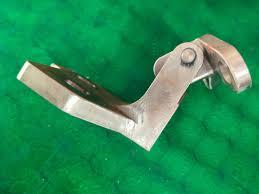Automotive Door Hinges Market Landscape: Evolving Components for Modern Mobility
The global automotive industry is experiencing a paradigm shift driven by electrification, smart technologies, and sustainable manufacturing. While the focus often lies on engines, batteries, and infotainment systems, critical mechanical components such as automotive door hinges continue to play a vital role in vehicle design, safety, and user experience. As vehicle architecture and consumer expectations evolve, the landscape of the automotive door hinges market is undergoing significant transformation.
This article offers an in-depth look at the current and future landscape of the automotive door hinges market, analyzing market structure, trends, innovations, competitive dynamics, and regional developments shaping the industry.

Overview of the Automotive Door Hinges Market
Automotive door hinges are mechanical assemblies that allow vehicle doors to open and close. These components may appear basic, but their performance influences vehicle safety, aesthetics, and functionality. They must withstand repeated usage, endure harsh environmental conditions, and meet evolving structural requirements—especially in the age of electric vehicles (EVs), advanced driver-assistance systems (ADAS), and smart cars.
In 2023, the global automotive door hinges market was valued at approximately USD 4 billion and is projected to grow to USD 5.5–6 billion by 2030, at a CAGR of around 4.5%. This growth is being fueled by rising vehicle production, increasing adoption of EVs, and design shifts favoring comfort, durability, and safety.
Market Segmentation
The automotive door hinges market can be segmented by:
-
Type: Front door hinges, rear door hinges, hood and trunk hinges
-
Material: Steel, aluminum, composite
-
Vehicle Type: Passenger cars, light commercial vehicles, heavy commercial vehicles
-
Sales Channel: OEM (original equipment manufacturer) and aftermarket
-
Region: North America, Europe, Asia-Pacific, Latin America, Middle East & Africa
Key Market Drivers
1. Electric and Autonomous Vehicles
As the industry transitions toward electric mobility, the need for innovative door systems is growing. EVs often feature non-traditional door designs—like suicide doors, gullwing doors, and sliding doors—that demand specialized hinge mechanisms. Autonomous vehicles, emphasizing accessibility and functionality, also encourage the use of powered or smart hinges integrated with sensors.
2. Design and Aesthetics
Modern automotive design emphasizes seamless integration of components, aerodynamic efficiency, and enhanced ergonomics. Door hinges must now be compact, lightweight, and unobtrusive, supporting sleeker door profiles while ensuring strength and longevity.
3. Material Innovation
Manufacturers are shifting from traditional steel to lightweight materials such as aluminum and high-strength composites. These materials help reduce overall vehicle weight, improve fuel efficiency, and support global sustainability goals. Additionally, anti-corrosion coatings and self-lubricating technologies are becoming standard in premium hinge systems.
4. Safety and Regulation
Global safety standards require vehicle doors to remain intact during collisions and provide easy egress in emergencies. Hinges are increasingly being engineered to absorb impact energy and prevent door detachment, meeting stringent crash safety regulations, particularly in Europe and North America.
Challenges in the Market Landscape
Despite the promising outlook, the automotive door hinges market faces several challenges:
-
Design complexity for new-generation vehicles increases production costs and prototyping time.
-
Raw material cost volatility affects pricing strategies.
-
Standardization difficulties due to the vast diversity in vehicle platforms and OEM requirements.
-
Global supply chain disruptions, as seen during the COVID-19 pandemic and recent geopolitical tensions.
Regional Market Landscape
Asia-Pacific
Asia-Pacific leads the market, thanks to its dominance in global automotive production. China, Japan, India, and South Korea contribute significantly to demand, driven by both volume manufacturing and rising EV adoption. The region also benefits from low production costs and strong export capabilities.
North America
The North American market is mature and innovation-driven. High consumer demand for SUVs and pickup trucks—which have heavier and more complex doors—drives growth. Automakers in the U.S. and Canada are investing in advanced, durable hinge technologies.
Europe
Europe emphasizes environmental sustainability and design excellence. Automakers focus on lightweight materials, smart hinge integration, and precision engineering. The EU’s strict safety and emissions regulations influence the region’s market landscape.
Latin America & Middle East
Though smaller in size, these regions present emerging market opportunities due to rising vehicle ownership, economic development, and infrastructure expansion. OEM investments in local production could further stimulate growth.
Competitive Landscape
The automotive door hinges market is moderately consolidated, with several key players shaping its trajectory. Major companies include:
-
AISIN Corporation
-
Gestamp Automoción
-
Shiroki Corporation
-
Magna International
-
Multimatic Inc.
These companies are engaged in strategic partnerships with automakers, expanding production facilities in key regions, and investing in R&D for smart and lightweight hinge technologies.
Startups and Tier-2 suppliers are also emerging with niche innovations, particularly in electric mobility and customized hinge solutions for concept and luxury vehicles.
Future Outlook
The future of the automotive door hinges market lies in adaptability, sustainability, and integration. Trends likely to shape the coming decade include:
-
Modular and scalable hinge designs for shared platforms
-
Integration with IoT systems for predictive maintenance and automation
-
Customization and aesthetics for luxury and lifestyle vehicles
-
Circular economy practices, including recyclable materials and end-of-life reuse strategies
As vehicles become more intelligent and personalized, door hinges will evolve from passive mechanical parts to active contributors to vehicle performance and user experience.
Conclusion
The automotive door hinges market landscape is expanding from a traditional mechanical segment to a dynamic, tech-infused domain. Amid shifting regulations, rising consumer expectations, and emerging vehicle technologies, door hinges are becoming critical touchpoints of innovation. Stakeholders who anticipate trends, invest in advanced materials, and embrace digital transformation will lead the next wave of mobility design.
- Art
- Causes
- Crafts
- Dance
- Drinks
- Film
- Fitness
- Food
- Games
- Gardening
- Health
- Home
- Literature
- Music
- Networking
- Other
- Party
- Religion
- Shopping
- Sports
- Theater
- Wellness


